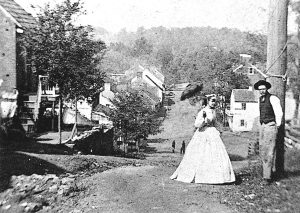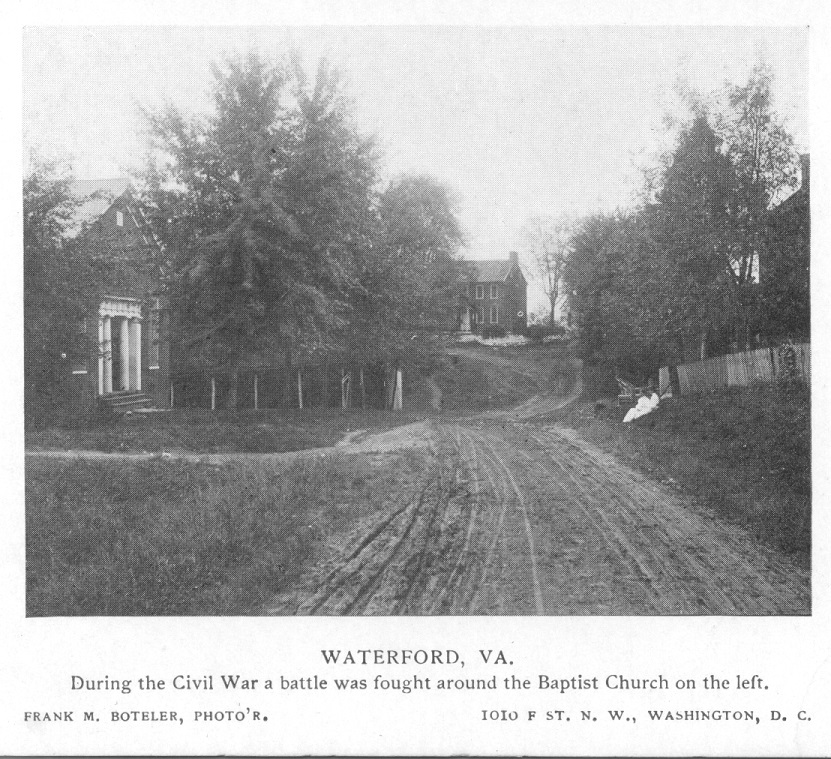Considering the remarkable story of the Waterford News, a Civil War era pro-Union newspaper published by three young Waterford ladies within secessionist Virginia, perhaps the most unexpected delight is the editors’ abilities to maintain their senses of humor during such a distressing time of war and uncertainty. A perfect example of their refreshing tone is an unlikely recurring character in their paper: the mud-hole.

The mud-hole first appears in May 1864 in Vol. I, No. 1 as a sardonic entreaty to the women of Waterford to remedy a situation that the men of the town have seemingly ignored:
“Pop-Gun.
[General Order, No. 6]
The young ladies of Waterford, Loudon Co., VA., are hereby notified to meet the first opportunity and lend their mutual aid in filling a large mud-hol with stone, said mud-hole being located in the middle of Second Street, and the men have driven around it so much that it is extending each side. Being fearful the gentlemen will get their feet muddy, the ladies will try and remedy it.”
The notice appears to have had some impact with the local citizenry, as noted by the follow up item in June 1864 in Vol. I, No. 2. However, we see that not all constituents favor the elimination of the mud-hole entirely:
“We record with pleasure one exception to the general apathy of the gentlemen. Are sorry ‘tis only one; but think the truth should not be withheld. Our thanks are due to the citizen for one load of sand deposited in the mud-hole. It will gladly be the recipient of a dozen more. We think it well to forewarn all young ladies of other neighborhoods not to let their heart’s devotion rest on young men who are so lost to the spirit of chivalry once the boast of Virginia’s sons. If that is not a sufficient reason, we would add they should not be so ungenerous as to interfere with the future prospects of the ladies here, which are slim enough anyhow.”
—
“Misses Editors of ‘Waterford News’” – Will you allow a much abused member of the Porcine species a word in your columns? Hitherto one of the greatest enjoyments of myself and fellow grunters, was an afternoon siesta in the mud hole on Second street, which enjoyment you have been the means of lessening by having one cartload of sand deposited in the deepest and most comfortable corner. If it should be filled, I don’t know where we shall go, for there is not another such a mud hole in the corporation.”
The readers must have taken the plea from the local pig to heart, as little progress is mentioned in future issues; however, one should not assume that the problem was solved. The mud-hole reenters the narrative in November 1864 in Vol. 1, No. 6:
“All who wish to behold the great curiosity of muddy streets in Waterford, can be gratified by visiting our town at this time. We will be happy to show our friends around.”
…
Wants.
…
“Wanted–A plaster for the mud-hole, it is breaking out again.”
The mud-hole persists throughout the winter, although it changes with the seasons. In January 1865 in Vol. I, No. 7, we learn:
“The mud hole at which we grumbled so much, has transmogrified itself into a skating pond, and is the daily resort of quite a number of boys, to say nothing of children of a larger growth, who we think appear interested.”
And in April 1865, the final issue Vol. I, No. 8, the editors include the latest updates on the situation, seemingly resigned to a fate of muddy streets for the foreseeable future:
“The ice and snow having disappeared, the mud hole has again made its appearance. It looks perfectly natural.”
The saga of the Second Street mud-hole is just one example of entertaining bits of humor sprinkled throughout the eight issues of the newspaper. It also serves as proof that some of the more mundane aspects of community and village life have changed little since the 1860s. Each spring brings mud along with flowers, roads need constant maintenance, and one man’s nuisance is another man’s (or pig’s) luxurious mud-hole.
Find the complete collection of all eight issues of the Waterford News online here to read more from these remarkable young ladies.
